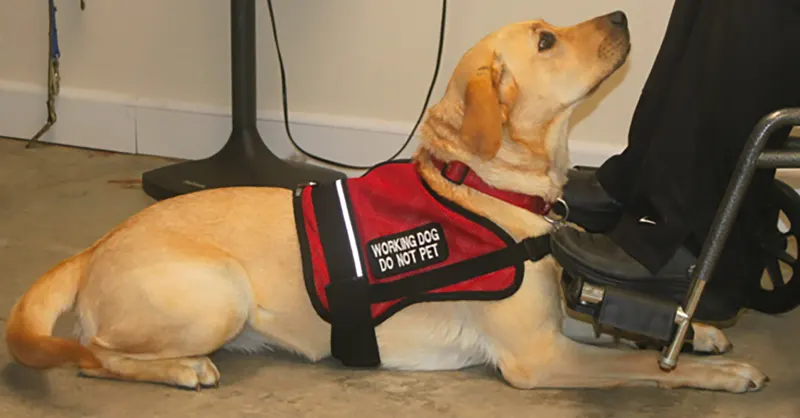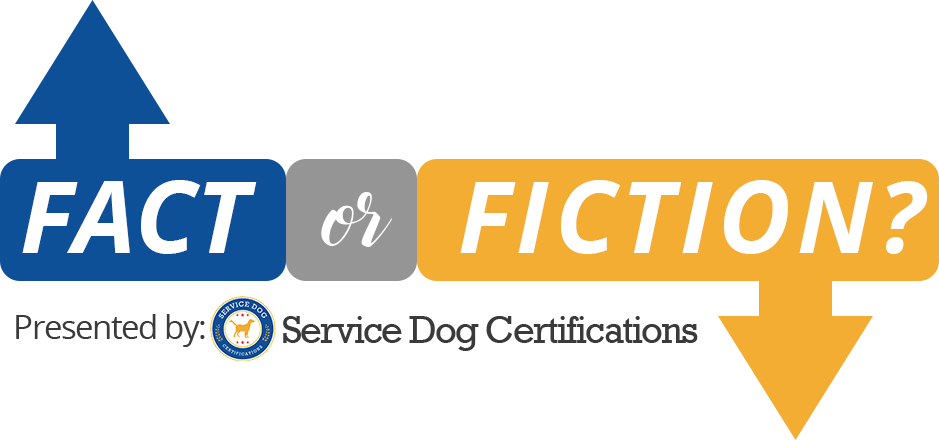Archive for the ‘Service Dog Tips’ Category
The use of Assistance Animals can be a great help to those with various disabilities, but some people still don’t fully understand everything about them. Here we will debunk the 10 most common myths about Assistance Animals. We have also included links to helpful articles throughout this page that includes more information.
Myth #1 – Service Dogs, Emotional Support Animals, and Therapy Dogs are the sameThis is absolutely not true! While each serves similar purposes – which is to aid the well-being of their owner in some way – Service Dogs, Emotional Support Animals and Therapy Dogs are used for very different forms of therapy and have different rights in the eye of the law.
Service Dogs are specifically trained to perform tasks that aid their owners’ disabilities, allowing them to live an independent lifestyle. Emotional Support Animals can be any animal that is used to provide their owner with emotional comfort and do not require special training. Therapy Dogs are often found in establishments where various forms of therapy are applied – ranging from care homes to physical rehabilitation centers. Their roles can vary significantly, from aiding a child to confidently read out loud from a book to assist those requiring physical therapy. A Therapy Dog is basically an ESA that helps a lot of people and not just their handlers. Unfortunately, therapy dogs do not enjoy the legal protection that the other assistance animals have. Myth #2 – Emotional Support Animals can come with me into hotels, restaurants, and marketsNo – only ADA accredited Service Dogs may accompany their owners into public areas, as they will have been adequately trained and certified to behave appropriately, and are deemed a necessity for their owners. However, there are some exceptions. When adequate documentation has been presented, Emotional Support Animals are allowed to live with their owners, even in pet-free buildings, and travel with them in the cabin of airlines with ESA programs. Only animals that have received a Service Dog Certification are automatically granted public access rights.
Myth #3 – Service Dogs must wear a vestContrary to popular belief, it is not a legal requirement for Service Dogs to wear a vest. However, many Service Dog owners choose to have them wear a vest to avoid any unnecessary hassle.
Myth #4 – You need a doctor’s note for your Service DogA doctor’s note is not necessary for a Service Dog. When entering public establishments, it is only necessary to verbally inform staff of your Service Dog – if they ask. The Americans with Disabilities Act (ADA) states they may only ask 2 questions:
Is the dog a service animal required because of a disability? What work or task has the dog been trained to perform?Service Dog owners may choose (though are not required) to order an ID card, as these can make the identification process much smoother. Rather than have to explain a disability, which can cause embarrassment, presenting an ID card can instantly verify the Service Dog. Emotional Support Animals, however, do require an ESA letter from a licensed therapist.
Myth #5 – It is illegal to qualify for an ESA letter onlineWrong. In fact, the opposite is true. Telehealth – a collection of means for enhancing the education and care of a patient – encourages online applications for ESA letters. Rules vary from state to state when obtaining an ESA letter. By using an accredited online organization that follow your state’s telehealth service laws, you can be sure you are abiding by your state’s relevant laws.
Myth #6 – All ESA letter referral sites are the sameNo. There is a broad range of referral sites ranging from mental health professionals who offer the provision of ESA letters as a part of their service, to dedicated single therapist letter mills. It is highly recommended to conduct as much independent research before choosing an ESA letter referral company, as you need to be certain the vendor is genuine and abides by your state’s rules.
Myth #7 – Each state has different Service Dog lawsNo. Service Dogs are protected by federal law under the ADA (Americans with Disabilities Act). However, Service Dog are subject to certain state-specific regulations. For example, Connecticut law recommends Service Dogs only access public areas with their owner while wearing a harness or an orange-colored collar and leash.
Myth #8 – A landlord can reject an ESA or Service Dog if they do not feel the tenant has a disability or needs an ESAUnder the Fair Housing Act (FHA), landlords are permitted to accept tenants with an Emotional Support Animal, regardless of any pet-free policies they may have in place. If a landlord does not accept your ESA, you should file a claim with HUD (US Department of Housing and Urban Development). They will assist you with each step of your claim.
Myth #9 – Service Dogs are only for the blind and people in wheelchairs, all other service dogs are fakeWhile guiding and pulling are perhaps the most well-known tasks performed by Service Dogs, they perform a variety of other specific tasks to aid a disability of any form. It’s not just physical disabilities that Service Dogs can be used for, but mental disabilities, too. Here are some examples:
Visual impairment/blindness Hearing Impairments Mental illnesses such as posttraumatic stress disorder (PTSD) or chronic depression Seizure disorder Mobility impairment Diabetes Myth #10 – Therapy dogs have the same access rights as ESA or Service DogsNo. Therapy Dogs must be granted access by prior agreement to certain establishments such as hospitals, libraries, and skilled nursing facilities. While Service Dogs are legally permitted to accompany their owners in all public areas, and Emotional Support Animals are protected in certain areas such as housing and travel, Therapy Dogs do not benefit from similar access rights.
Psychiatric Service Dogs (PSDs) are hard at work helping people with invisible mental health conditions. While most people think of service dogs as assisting with physical disabilities, PSDs are trained to help with mental health conditions and have the same legal rights as service dogs that assist with physical disabilities. We will explain what psychiatric service dogs are, who qualifies for one, the type of work they do, and the legal rights and protections that PSD owners have under U.S. federal laws.
What is a psychiatric service dog?In brief: Psychiatric service dogs (PSDs) help with mental health conditions and have the same legal rights as service dogs that assist with physical disabilities.
PSDs vs ESAs: Psychiatric service dogs are similar to emotional support animals (ESAs), but with one major difference. Unlike ESAs, PSDs undergo specialized training to help people with mental illnesses and learning disabilities.
Rights: PSDs have broad public access rights that allow them in public places where pets or emotional support animals aren’t allowed. PSDs can also fly on planes free of charge.
Table of contents Qualifying for a psychiatric service dog Psychiatric service dog tasks Overview of psychiatric service dog access rights How to get a letter for a psychiatric service dog ADA requirements for a psychiatric service dog Training a psychiatric service dog Different types of psychiatric service dogs How do I register my psychiatric service dog? Qualifying for a psychiatric service dogEligibility: To be eligible for a psychiatric service dog, you must have a mental health condition that substantially limits one or more major life activities. The ADA defines a mental health disability as “any mental or psychological disorder” such as “emotional or mental illness, and specific learning disabilities.”
You can ask a licensed mental health professional for a PSD letter to document and confirm whether you have an eligible condition.
Qualifying Mental Health Disabilities:
Major depression (Clinical depression) Anxiety disorders (i.e., generalized anxiety disorder (GAD), social anxiety, etc.) Phobias (i.e., specific or general phobias) Post-traumatic stress disorder (PTSD) Attention-deficit hyperactivity (ADHD) Manic depression (Bipolar disorder) Obsessive-compulsive disorder (OCD) Autism spectrum disorder (ASD)PSD training: In addition to having a psychiatric, intellectual, or other mental health condition, the handler must need a task-trained dog to assist with their condition. The key difference between a psychiatric service dog and a normal dog is that a PSD must be trained to perform work relating to their handler’s disability.If the PSD does not perform a task relating to the owner’s disability but provides comfort through its companionship during difficult times, it is more likely an emotional support animal. In the next section, we will give some examples of the tasks that PSDs are entrusted to perform.
If you want to know if you qualify for a Psychiatric Service Dog, apply for your PSD Letter. Through our partner, we can connect you with a licensed healthcare provider so they may assist you. Psychiatric service dog tasksPsychiatric service dogs are trained to do work that allows people with psychiatric disabilities to function in everyday life. There are too many of these tasks to list in one article, but below is a sample of the important jobs that PSDs perform.
Some common tasks are:
Retrieve medications – pick up medication from a table or ring a bell as a reminder Tactile stimulation and deep pressure therapy (DPT) – can use touch or gentle pressure to provide calm and comfort to a handler that is in distress Ground and reorient – can help ground their handler back into a more present state of mind during an anxiety attack. Interrupt and redirect – can help limit obsessive–compulsive and self-destructive behaviors by interrupting or redirecting Find a person/place – can locate people/places for those with severe anxiety in crowded environments Navigation and buffering – can provide a buffer and help guide their handler through stressful environments Room search – can perform a room search to help those that suffer from hyper-vigilance caused by PTSD. Stabilize routines – can help their handler maintain healthy routines by, for example, preventing them from oversleeping or reminding them to do daily tasks.No matter what task your PSD is trained to perform, you have a right to privacy and dignity when it comes to your condition and needs for a service animal. Under the ADA, staff members at an establishment are prohibited from asking you to demonstrate the tasks your PSD has been trained to perform.
Overview of psychiatric service dog access rightsPsychiatric service dogs have the same access rights as other types of service dogs. Under the ADA, state and local governments, businesses, and other organizations that serve the public have to let PSDs accompany their owners in all areas where the public is allowed to go.
PSD handlers also have the right to live with their dogs in most types of housing under the Fair Housing Act. Owners of PSDs do not have to pay fees or deposits to their landlord or housing association in order to have a PSD in their residence. Even if the building strictly bans all dogs, psychiatric service dogs must still be allowed.
In addition, under the DOT’s air travel rules, PSDs are allowed to fly in the cabin with their owners, free of charge. In order to fly with a PSD, owners must submit the DOT’s Service Animal Air Transportation Form to their airline in advance.
Below are examples of places a psychiatric service dog has access to in the US:
Housing and lodging – apartment buildings, condos, co-ops, rentals, hotels, college dorms, short-term rentals (Airbnb) Transportation – airplanes, taxis, and trains Public spaces – restaurants, bars, university campuses, offices, libraries, beaches, stores, parks, marketsShare this image on your site (copy code below): <div style="clear:both"><a href="https://www.servicedogcertifications.org/psychiatric-service-dog/" target="_blank"><img decoding="async" style="max-width:100%;margin:0 0 10px;" src="https://www.servicedogcertifications.org/wp-content/uploads/2017/09/PSD-Access-Rights-infographic.jpg" title="Psychiatric Service Dog Access Rights" alt="PSDs have access rights to housing, transportation and public spaces" border="0" data-src="" /></a></div> Copy
No matter where you take your PSD, it’s always important to keep in mind that if your PSD is misbehaving, it can be asked to leave the premises. Service animals can be denied entry if they are acting aggressively, barking or growling repeatedly, or causing an unsanitary condition. A psychiatric service dog has to be under the handler’s control at all times when out in public.
How to get a letter for a psychiatric service dogMany Psychiatric Service Dog owners get what are known as PSD letters from their healthcare provider. A PSD letter contains a healthcare provider’s opinion on whether a person has a qualifying ADA psychiatric disability or learning disorder.
Documentation for service dogs is not required under the ADA. For handlers with invisible disabilities, however, in the form of a psychiatric illness, a PSD letter provides confirmation that they meet service dog disability standards.
PSD letters are written by licensed mental health professionals such as doctors, psychologists, psychiatrists, social workers, and nurse practitioners. Your provider will first evaluate your mental health and determine whether it meets the criteria of being a disability under the ADA. If you qualify, they can give you a signed PSD letter stating you have an eligible ADA service dog disability.
ADA requirements for a psychiatric service dogPsychiatric service dog handlers have legal rights under the Americans with Disabilities Act (commonly known as the “ADA”). While some states may also have their own laws regarding service dogs, the ADA is a federal law that applies to all 50 states.
What you can be asked: Under the ADA, if you’re out in public or at an establishment and someone wants to verify your psychiatric service dog, they are allowed to ask two questions:
Is the dog a psychiatric service dog required because of a disability? What work or task has the PSD been trained to perform?The ADA website explicitly recognizes psychiatric service dogs and gives as examples service dogs that remind their handlers to take prescribed medication or calm a person with Post-Traumatic Stress Disorder (PTSD) during an anxiety attack.
ADA protections: Handlers of psychiatric service dogs,
Cannot be isolated from other patrons by a business Cannot be treated less favorably than other customers Cannot be charged fees that are not charged to other customers without animals. Cannot be charged a deposit or fee that would be paid by customers with normal pets.Some other requirements to note under the ADA, a handler cannot be asked to remove his psychiatric service dog from an establishment unless (1) the PSD is out of control and the handler doesn’t take effective action to control it, or (2) the PSD is not housebroken. Even when a PSD is properly asked to leave a site, the handler must be offered the opportunity to still obtain goods or services with the animal removed.
Training a psychiatric service dogBoth the ADA’s and the DOT’s rules permit owners to self-train their psychiatric service dogs. If you’re not comfortable training your own dog, however, you can hire a professional trainer or reach out to an organization. Note: there is no “official” training program for PSDs, although there are entities that issue guidelines and suggestions.
In addition to being trained to perform the task related to a handler’s disability, a PSD must always be under the control of its owner. Under ADA rules, a PSD must be harnessed, leashed, or tethered at all times, unless that would interfere with the PSD’s ability to work (in which case, the handler can use other means of control like voice commands or physical signals). For air travel, a PSD must always be harnessed, leashed, or tethered and not engage in disruptive behavior.
Tracking training milestonesThere are important milestones a PSD owner should track to determine whether their psychiatric service dog is ready to be taken in public:
Can the PSD ignore distractions? Is the PSD obedient even in busy areas? Does the PSD run after or lunge at other people and animals? Is the PSD calm when around children and other animals? Is the PSD able to maintain its focus on the handler even with the presence of food and treats? Does the PSD growl or bark uncontrollably? Can the PSD remain on task in loud, crowded places? Is the PSD calm around moving vehicles and traffic?These are just some of the tests you should make sure your PSD can pass with flying colors before going out in public. A PSD that is unruly can be asked to leave an establishment. Of greater concern, a poorly trained PSD may not be able to perform the critical duties it has been entrusted with if it is not accustomed to a particular environment.
Different types of psychiatric service dogsThere are many types of psychiatric service dogs that serve individuals with a wide range of invisible disabilities. Below are just a few examples:
PTSD PSDPost-Traumatic Stress Disorder may affect those that have gone through an extremely stressful or life-changing situation. Many people who suffer from PTSD use psychiatric service dogs to help treat their symptoms. Some of the tasks a PSD can perform for someone with PTSD include:
Help block and buffer the handler in crowded areas Calm the handler using deep-pressure therapy Retrieve medications Provide security enhancement tasks (such as room search) Interrupt destructive behaviors Depression PSDPeople who suffer from severe depression oftentimes do not want to leave their homes and find it difficult to engage in life activities. They have constant negative thoughts and are sometimes suicidal. PSDs help chronically depressed people get back to living a normal life by:
Providing comfort with responsive touch Retrieving medications (and reminding the handler to take them) Providing tactile stimulation by licking the face when the handler is distressed Helping the handler establish a daily routine Preventing the handler from oversleeping or being too sedentary Anxiety PSDAnxiety can strike us at any time, but for those that have chronic anxiety, it can be debilitating. This condition can create excessive uneasiness and apprehension and may lead to compulsive behaviors or panic attacks. A PSD can be trained to help anxiety attacks by:
Keeping the person grounded by licking or pawing Applying deep pressure therapy (for example, by lying across the handler’s body) Recognizing the signs of an impending panic attack Retrieving medications Leading the handler out of a building Alerting a loved one Finding/bringing a telephone Blocking people from crowding the handler How do I register my psychiatric service dog?What’s required: If you have a psychiatric service dog, you may benefit from voluntarily registering your animal with ServiceDogCertifications.org and obtaining service animal paraphernalia. Under ADA rules, registering a service animal does not confer legal rights, but registrations and service animal accessories are routinely used by handlers for their personal convenience.
Why do it: As someone with an invisible disability, you may want a method for strangers or workers to understand immediately that your animal companion is not just a pet or an emotional support animal. Not only does this help set proper boundaries, PSD registration and accessories can also help protect your privacy by reducing the need to answer unwelcome questions. Keep in mind this is completely optional and does not substitute for proper training and professional help in evaluating a psychiatric condition.
What can help: Vests, tags, ID cards, harnesses, and other service animal gear are designed to help you enter public spaces with your PSD with confidence. These items also help ward off annoying and potentially unsafe approaches by strangers and children who may not realize your PSD is a working animal and not a pet. Service Dog Certifications can keep your psychiatric service dog’s information in its registration database and issue an identification ID card, certificate, or vest, depending on your needs.
Under the Fair Housing Act, housing providers such as landlords, HOAs, co-ops, and condos must reasonably accommodate service dogs. Housing providers can only deny a tenant’s request to live with their service dog in limited circumstances. In this article, we’ll explore what these exceptions are and what rights you have as a service dog owner in residential housing.
Laws that Protect Assistance Animals in No Pet HousingThere are two types of assistance animals with special housing rights: service dogs and emotional support animals. If you have a mental or physical disability that requires you to have either a service dog or an emotional support animal, you are protected from discrimination under the federal Fair Housing Act. Service dog owners have the following rights:
Access to “no pets” policy housing Exemption from monthly pet fees Exemption from pet deposits Exemption from breed or weight restrictionsHousing providers must accommodate assistance animals unless they have a valid exemption, even if their building has a policy that bans all pets. Under federal Fair Housing rules, service dogs and emotional support animals are not considered pets and are thus not subject to rules that apply to normal pets.
A major difference between an emotional support animal and a service dog is that service dogs must be individually trained to perform a task or job relating to the handler’s disability. Emotional support animals, on the other hand, do not undergo any specialized training and assist with mental health disabilities just by being present in their owner’s life.
You may save and share this image. When can a landlord reject a service dog?The right to live with your service dog is not absolute. Landlords can reject a tenant’s request to live with their service dog if they have a valid exemption. For example, if the landlord has determined that the tenant’s service dog poses a health or safety risk to others, they may properly deny accommodation if the risks can’t be mitigated.
Some smaller landlords are also exempt from Fair Housing requirements. The Fair Housing Act exempts owner-occupied buildings with no more than four units and single-family houses sold or rented by the owner without an agent.
Landlords cannot reject a service dog solely because they merely perceive it as dangerous or a health risk to others without evidence. Landlords cannot deny a service dog, for example, solely because it is a certain breed.
Fair Housing rules also override any building policies that ban pets. A housing provider cannot deny a service dog accommodation because their building has a strict ban on all animals. A housing provider also can’t deny a service dog for being too big just because their building has a size/weight restriction on pets.
How can a landlord verify a service dog?Under HUD guidelines, housing providers are permitted to verify a service dog by asking two questions:
“Is the animal required because of a disability?” and “What work or task has the animal been trained to perform?”Housing providers are never permitted to ask about the nature or extent of a tenant’s disability or demand documentation as proof of service dog status. However, under HUD guidelines, housing providers are allowed to make the truth and accuracy of information provided during the service dog request part of the representations made by the tenant. This applies under a lease or housing agreement to the extent that the lease or agreement requires the truth and accuracy of other material information.
What that essentially means is that if you lie about the status of your service dog, your landlord may have the right to take actions against you under the terms of your lease. It’s also common sense that faking the need for a service dog is unethical, but it is also outlawed in many jurisdictions.
Overview on Service Dog Access RightsService dog owners have rights when it comes to housing and public access rights under the Americans with Disabilities Act. When you have a legitimate service dog, you have the right to access areas where the general public is allowed. This can include retail locations, restaurants, hotels, and beaches. Service dogs can also accompany their handlers in the cabin of airplanes free of charge.
Certifications and Vests for Service DogsCertificates, ID cards, and vests are not mandatory for service dogs, but many service dog owners choose to use them. You can obtain these items after your service dog has been fully trained to perform the task or job related to your disability.
Registering a service dog and obtaining items like certificates, ID cards, and vests help signal to other tenants in your building and members of the public that your dog is a working animal. It can help dispel any confusion about why your service dog is present, especially if your building has a ban on pets.
You can register your service dog here: Service Dog Certification.
You can also purchase a service dog vest at this link: Service Dog Vest.
Having a certificate, vest, or ID card for your service dog is an easy way to let others know that your canine companion is a working animal and, therefore, should be treated as such.






